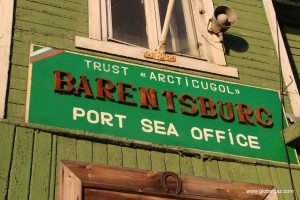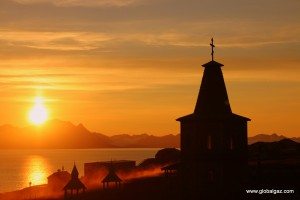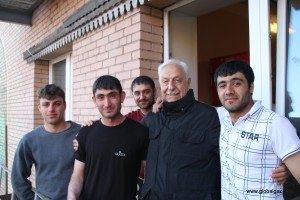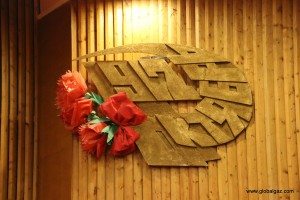Special for the Armenian Weekly
Svalbard, an isolated Norwegian island, lies in the Arctic Ocean between 74 and 81 degrees north latitude. During the summer the sun does not set for 99 days, and darkness reigns for 84 days in the winter. The 3,000 or so people that call Svalbard home are considered to live in the northernmost settlement in the world. The majority can be found in Longyearbyen, the de facto capital, while the second largest settlement is Barentsburg with 400 inhabitants.

Despite Svalbard being under Norwegian sovereignty, the lingua de Franca of Barentsburg is Russian. A unique treaty signed in 1920 allowed all signatories to exploit Svalbard’s resources; the only country to have taken advantage of this was Russia.
Barentsburg was originally founded as a Dutch settlement in 1920, but sold their concession to the Soviet Union in 1931. The Soviets—now Russians—have maintained a presence there since then mining coal. The coal is mined by the Russian state-owned Arktikugol Trust, which exports its coal primarily to northern Europe. Everything in the settlement is heavily subsidized, from housing to electricity, resulting in a financial loss to Moscow; yet it allows Russia to maintain a presence in this part of the world. Despite this Russian influence, Barentsburg still maintains both a Norwegian address and phone numbers.

This isolated mining village has created its own Russian ecosystem. An onion-domed Russian Orthodox Church rests in the settlement, built in honor of 140 miners who perished in a 1996 plane accident. Barentsburg has everything from an Olympic-sized swimming pool to a school, to the northernmost diplomatic mission in the world, the Russian Consulate. No roads lead to this settlement; it can only be reached via boat, snowmobile, or helicopter. Most supplies and food come directly from mainland Russia, and the settlement uses an electronic cash card to make transactions. (One might want to consider using the cash card at the northernmost brewery in the world, the Red Bear Brewery.) Barentsburg is also attempting to bring in its share of the global tourism dollar. A new hotel has been built, and visitors are free to peruse the souvenir shop or catch a performance at the cultural center.

I cannot imagine spending my next long weekend vacationing in Barentsburg, but it was a fascinating place to visit for a couple of hours. The settlement appeared to be stuck in a Soviet time warp. Soviet-like propaganda hugged the walls of the buildings. A plaque highlighted the revolution of 1917. A large Lenin bust hogged the town’s spotlight. (Difficult to believe, but this Lenin statue is not even the most northern statue. A nearby abandoned Russian mine claims that title.).

As we strolled around Barentsburg, my tour guide, Yuliya, shared with us the pan-Soviet nationality breakdown of the mining workforce. The majority of the workforce hailed from Ukraine, followed by Russia. Rounding out the settlement was a group of 20 from Armenia. My ears perked up. Armenia? My ethnic homeland. I grabbed my Dad and informed him that even in the Arctic Circle there were Armenians. (My Dad and I were vacationing on a cruise to Svalbard and Greenland.)
As the official tour ended, my Dad and I strolled down “Main Street” in near-freezing weather. As I stopped to take a picture of a building, I noticed a dark-haired man step out onto a balcony. He puffed a cigarette. In the cold, both his breath and cigarette smoke were visible. I had a feeling.

I meandered over and shouted a greeting in Russian: “Sdrastvuite.” He responded in kind. “Kak tebya zavoot?” I asked. He responded, “Vartan.”
A giant smile crossed my face. “Duk Hye ek?” Vartan quizzically replied “Ayo” My smile appeared again. “Yes Hye em.” “Akhper jan, arri, arri!” he barked excitedly.

My Dad and I entered his living quarters, relaxed on a worn couch, and shared and swapped stories. The seven Armenians from Gyumri surrounded us. Employing my awful Eastern Armenian and my Dad’s dated Western Armenian, we learned about these unlikely residents in one of the world’s northernmost settlements. As you might imagine, the harsh economics of Armenia drove them to this Russian mining town. The salary was several factors higher than what they would have earned in Gyumri. The group of Armenians was part of the construction and repair crew in Barentsburg, avoiding the harsher environment of the mines. The men spend six months in Svalbard and three months off in Armenia.
As an avid traveler I am always meeting Armenians, from Bangkok to Rio de Janeiro to Kolkata. But meeting Armenians at the roof of the world was a surprising and surreal experience.


Very cute story. I have a friend Odette Ricassa. She’s a world traveler and in one of those small cities, I think they call it North Pole met an Iranian taxi driver. I will post this story on my blog. Thanks for sharing
Hi Catherine… it is a very small world!
I’m surprised Norway, a NATO ally, allowed the Soviets to make such inroads. I’m sure more spying was going on than coal mining.
It is a strange situation. There was a treaty signed in 1920 which allowed many countries to set up businesses in Svalbard. The Soviets took advantage of this. And from what I understand there were some hijinks during the cold war.
Such a beautiful story !
Great! Whenever two of us may meet anywhere on Earth we might not live up to the Saroyan dictum, but we will have some fun.
A relative of mine married a Polish woman who earlier was married to a Wehrmacht Captain. His formation was stationed in Normandy. His troops were Armenians and Georgians taken as Red Prisoners. On 6/6/44 they refused to shoot at Americans.
The Captain hated them by this time because they laughed, smiled, found or made wine and khoravadz, and lived as Armenians despite being in France, being commanded by Nazis and facing death.
brilliant, well done. Armenians are smart, they are industrious they are hard working and good on them for working somewhere where not many would go to.
Good on you for writing this.
Hi Robert….Thanks for the comment, and I agree with you as well!
If you want to know more about the three Armenian Unis in SS uniform, look for the film on You tube called “the women of Zeeland”. When they caught Jews, they would sometime hide them among themselves, in plain sight, wearing their uniforms, until the underground could take them over to evacuation to England. They sent word to England. Give us the guns and ammo and we’assault the German units and hand you the Island. But they were ignored.
Hi Ric, I absolutely love this tale. When I moved up to Humboldt County in northern California for school (population 10,000) you must understand how it felt to find 7 Armenian students and a professor (instant family) and finding out one of the most prominent members of the Humboldt Community is Armenian. Same thing happened in Singapore and Vietnam, it’s a great feeling. Not many people who are not of Armenian descent really “get what the big deal is,” when you find a community of Armenians in the far reaches of the world. As I like to say, there may not be many of us, but we are everywhere ;)
Hi Susan:
I agree. I definitely fell a thrill when I meet Armenians in a random place.
Very interesting and amusing story may I ask what was the name of the cruise and how many days was it ? as I am a world traveller myseld.
Jano
Hi John:
It was 14 days-Svalbard, Greenland, and Iceland. The cruise line was Hurtigruten, but I strongly do not recommend them.
what a nice story, I feel bad for our Gyumri guys, but thats is our Armenian fate most in foreign lands but yet all true Armenians till death
Thanks for your comment!
Just seeing that statue and sign makes me vomit. I am sure Putin has it in his sight to invade and take over one day. If that man had work in his country he would not stay in that isolation. I feel sorry for him.
News flash… that statue and Putin don’t have anything to do with each other, and in fact, are opposed ideologically, Putin is not a Bolshevik the western media is trying to make him out to be. And in fact that statue does need to be torn down, as it represents one of the biggest crimes of history.
Bravo to you Ric – quite a surprise when I read your comments and that Charlie is with you – hope to see you one of these days.
Thank you!! We had a great trip together!
Warm story.
Don’t be surprised if they find Armenians on Mars tomorrow.
I think it’s time for all of us to go back home.
Agreed!!
My poor countrymen! The mafiosi regime in Armenia spread them as far as Arctic! And their native Gyumri is still in miserable state. When this awful situation in Hayastan will end?
I loved this wonderfully written story because, as a world traveler myself, I have my own little basket of unusual Armenian encounters.
It’s great to read or hear about the tales of others too.
Hi Dorothy…great to hear you have had similar experiences!
Ric: I just saw this link you emailed me at dinner last Christmas. What an enjoyable read! – Cousin Ken
Hello!!
I ambgoibg to Svalbard tomorrow and would like to contact these Armenians as I am also Armenian.
Does any of you have contacts from them?
Thanks in advance!!
ՇՆՈՐՀԱԿԱԼ ԵՄ
It was interesting to come across Armenians whenever I was travelling and we were very happy to socialize. I remember having some problems at an Airport when a French officer objected that I was carrying extra French Francs. I could tell from the way he looks that the officer was an Armenian and I told him in French “You sure are an Armenian and so am I. You have to help me out”. Immediately everything was taken care of and I said in Armenian “shenorhagal em”. This is an incident that happened 45 years ago which I will never forget.